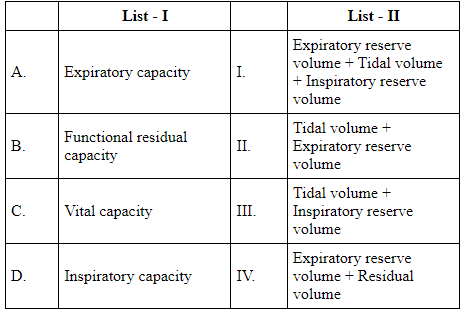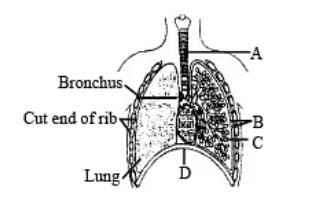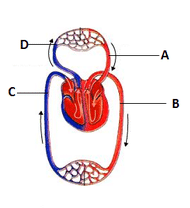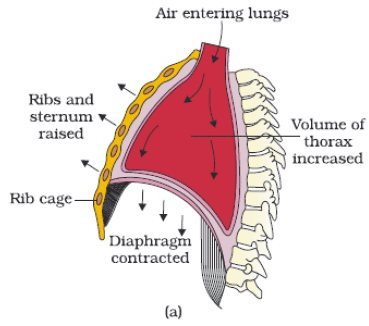31 Years NEET Previous Year Questions: Breathing & Exchange of Gases - NEET MCQ
30 Questions MCQ Test - 31 Years NEET Previous Year Questions: Breathing & Exchange of Gases
Match List I with List II:

Choose the correct answer from the options given below: [2024]

Which of the following factors are favourable for the formation of oxyhaemoglobin in alveoli? [2024]
Vital capacity of lung is _________. [2023]
Which of the following is not the function of conducting part of respiratory system (NEET 2022 Phase 1)
Under normal physiological conditions in human being every 100 ml of oxygenated blood can deliver ___________ ml of O2 to the tissues. (NEET 2022 Phase 1)
Which of the following statements are correct with respect to vital capacity? (NEET 2022 Phase 2)
(a) It includes ERV, TV and IRV
(b) Total volume of air a person can inspire after a normal expiration.
(c) The maximum volume of air a person can breathe in after forced expiration.
(d) It includes ERV, RV and IRV.
(e) The maximum volume of air a person can breath out after a forced inspiration.
Choose the most appropriate answer from the options given below :
Select the favorable conditions required for the formation of oxyhemoglobin at the alveoli. [2021]
Select the correct events that occur during inspiration. [2020]
(i) Contraction of diaphragm
(ii) Contraction of external inter costal muscles
(iii) Pulmonary volume decreases
(iv) Intra pulmonary pressure increases
Tidal Volume and Expiratory Reserve Volume of an athlete is 500 mL and 1000 mL respectively. What will be his expiratory capacity if the residual volume is 1200 mL? [2019]
Which of the following options correctly represents the lung conditions in asthma and emphysema, respectively? [2018]
Lungs are made up of air-filled sacs, the alveoli. They do not collapse even after forceful expiration, because of [2017]
Reduction in pH of blood will [NEET 2016 Phase 1]
Lungs do not collapse between breaths and some air always remains in the lungs which can never be expelled because [NEET 2016 Phase 2]
Name the chronic respiratory disorder caused mainly by cigarette smoking. [NEET 2016 Phase 2]
Asthma may be attributed to [NEET 2016 Phase 2]
The partial pressure of oxygen in the alveoli of the lungs is [NEET 2016 Phase 2]
When you hold your breath, which of the following gas changes in blood would first lead to the urge to breathe? [NEET 2015 / AIPMT 2015 ]
Approximately seventy per cent of carbon dioxide absorbed by the blood will be transported to the lungs: [NEET 2014 / AIPMT 2014 ]
The figure shows a diagrammatic view of human respiratory system with labels A, B, C and D. Select the option which gives correct identification and main function and/or characteristics. [NEET 2013]

Figure shown schematic plan of blood circulation in humans with labels A to D. Identify the label and give its function’s. [NEET 2013]

Which one of the following is one of the paths followed by air/O2 during respiration in an adult male Periplaneta americana as it enters the animal body? [NEET Kar. 2013]
Which of the following are the correct statement for respiration in human [2012]
Which one of the following is a possibility for most of us in regard to breathing, by making a conscious effort? [2011M]
Listed below are four respiratory capacities (i–iv) and four jumbled respiratory volumes of a normal human adult: [2010]

Which one of the following is the correct matching of two capacities and volumes?
Which two of the following changes (a–d) usually tend to occur in the plain dwellers when they move to high altitudes (3,500 m or more)? [2010]
(i) Increase in red blood cell size
(ii) Increase in red blood cell production
(iii) Increased breathing rate
(iv) Increase in thrombocyte count
Changes occurring are:
Which one of the following mammalian cells is not capable of metabolising glucose to carbon-dioxide aerobically? [2007]
People living at sea level have around 5 million RBC per cubic millimeter of their blood whereas those living at an altitude of 5400 metres have around 8 million. This is because at high altitude [1995, 2006]
When CO2 concentration in blood increases, breathing becomes [2004]
Blood analysis of a patient reveals an unusually high quantity of carboxyhaemoglobin content. Which of the following conclusions is most likely to be correct?The patient has been inhaling polluted air containing unusually high content of [2004]
Skin is an accessory organ of respiration in [1990]















